You will be redirected to a Leads.io registration page.

Get up to 3 quotes from our selected suppliers by filling in only 1 form

Save money by comparing quotes and choosing the most competitive offer

Our service is 100% free and with no obligation
- GreenMatch.com
- Solar Energy
- Solar Panels
Find the Best Solar Panels in the US
Are solar panels the right choice for your home?

Solar panels take advantage of one of nature’s most powerful yet free energy resources: the sun. There are two technologies that primarily aid in harnessing the sun’s energy and turning it into electricity. These technologies are the well-known photovoltaic system and the concentrating solar power (CSP).
The photovoltaic system (PV systems), also known as solar panels, use semiconductor technology to convert solar energy into electricity that can power your household. The CSP, on the other hand, is ideal for large power plants rather than residential use. Mirrors are used to concentrate sunlight on the receivers in the solar panels, converting it into heat, which is then used to produce electricity.
But are they the right solution for your home?
The year 2022 witnessed a nearly 40% growth in the residential solar market compared to 2021, with 5.9 GW installed in homes across the country. The growing popularity of solar panels means that the prices have gone down by more than 50% over the past decade, and the trend seems to be continuing.
The prices of solar panels have steadily decreased over the last years, as new technologies have been discovered to make solar energy components more cost-efficient. Solar panels not only help reduce your energy bills but can also help you earn money from surplus electricity generated.
So, the 3 key benefits of solar panels are:
Electricity all year round – Solar panels generate clean, emission-free electricity to power your home all year round, while their long life span of more than 25 years makes them a good long-term investment.
Increase the market value of your property & earn money from solar grants – Selling surplus electricity generated by your solar panels is another advantage that solar panels offer. You will not simply earn money from surplus electricity generated, but also increase the market value of your house.
Reduce your carbon footprint – A solar-powered home reduces the carbon footprint and helps to eliminate domestic harmful emissions.

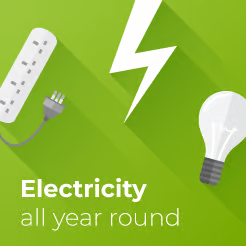

Thinking of going green and reducing your carbon footprint? You’re at the right place. GreenMatch can help you get up to three free competitively priced quotes from certified installers. Simply click on the button below and start comparing quotes.
Fill in the form in just 1 minute
How do solar panels work?
When speaking about solar panels, it is important to distinguish between two main types:
Solar photovoltaic panels
Photovoltaic (PV) systems are a commonly used solar panel system in the US. Photovoltaic systems convert sunlight directly into electricity.
Solar cells are made of semiconductors, such as silicon, which absorb sunlight and convert it into electricity.
Solar cells are connected electrically and packed together in a frame, commonly known as a solar panel. When you connect multiple solar panels together, they form a solar array. And, finally, when you add the cabling, brackets, inverter, and so forth, the entire system forms your solar panel system.
The electrical conductors are attached to positive and negative terminals, thus forming an electrical circuit. From there, the electrons can be captured in the form of an electric current (electricity). This current, together with the cell’s voltage (which is a result of its built-in electric field or fields), defines the power (or wattage) that the solar cell can produce and is how solar panels convert sunlight into electricity.
There are three types of PV systems:
Solar Thermal Collectors
Solar thermal panels use sunlight to heat up water that is stored in a cylinder, which can then be used for your home heating needs. Solar thermal panels are roof-mounted, just like electric solar PV panels, but look slightly different, as instead of cells they have multiple pipes that heat up water. A related technology is thermodynamic panels, which extract heat from the ambient air.
Both solar thermal and thermodynamic panels can be used for space heating, but most commonly they provide the domestic hot water (DHW) needs of households.
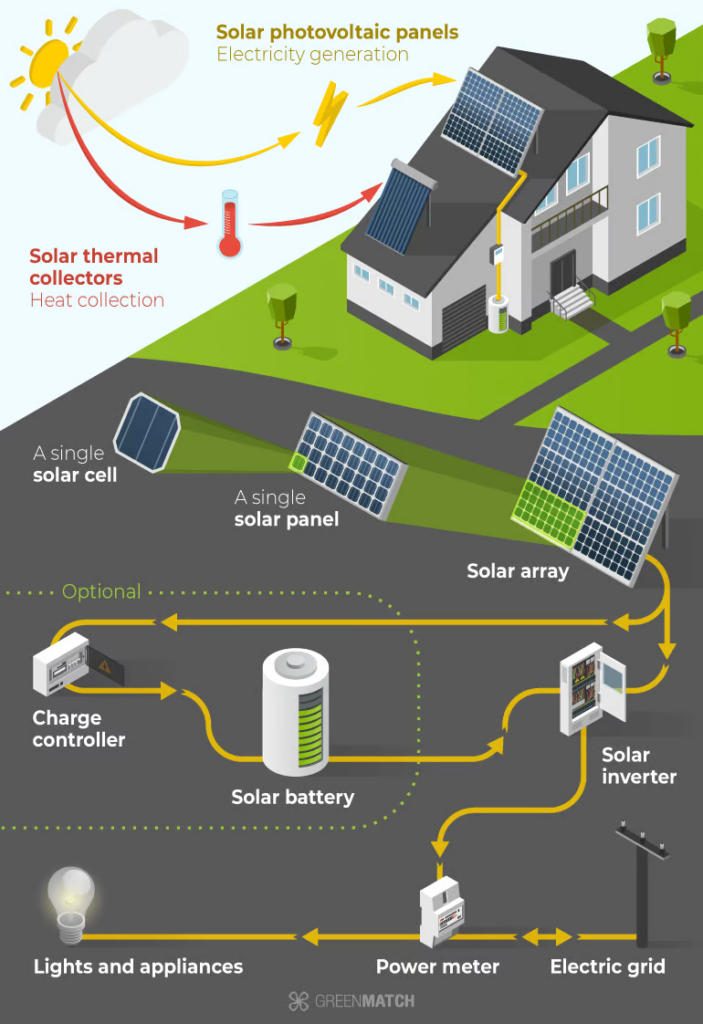
Already have an idea of what you’re looking for and don’t want to waste any more time? Simply click the button below to get up to 3 of the best solar panel quotes. It’s completely free and you’re under no obligation to accept any of the quotes you receive.
Fill in the form in just 1 minute
4 Main Factors Affecting Solar Panel Efficiency
You’ll want to maximize your solar panel efficiency to get the most out of your solar investment and to cut your expenditure on utility bills. Key factors to consider are location, angling, direction, roof suitability, size of the solar panel system, and correct maintenance. Let’s have a look one by one.
1. Location, angle, and direction
Is the PV system located and angled so that solar cells can capture the maximum amount of sunlight?
Assessing your roof’s suitability to withstand solar panels is a crucial step in determining the efficiency of the system. The orientation and angle of your roof have a lot to do with how much sunlight exposure your panels will get.
The optimal direction for solar panels is south-facing, as it would mean the panels are exposed to sunlight for as long as possible. According to Stanford University, a 34° roof tilt angle is the best position for solar panels to be more efficient.
| Roof Angle | Orientation | ||||||
|---|---|---|---|---|---|---|---|
| North West135° | West90° | South West45° | South0° | South East–45° | East–90° | North East–135° | |
| 0° | 83.5% | 83.5% | 83.5% | 83.5% | 83.5% | 83.5% | 83.5% |
| 15° | 73.6% | 83.5% | 90.2% | 93.7% | 90.8% | 83.0% | 74.3% |
| 30° | 64.0% | 79.4% | 93.3% | 99.3% | 94.5% | 81.2% | 65.4% |
| 34° | 61.7% | 78.4% | 93.5% | 100.0% | 94.8% | 80.4% | 63.1% |
| 45° | 55.6% | 75.1% | 92.5% | 99.9% | 94.1% | 77.3% | 56.9% |
| 60° | 47.4% | 68.7% | 87.5% | 95.7% | 89.4% | 70.7% | 48.3% |
| 90° | 30.3% | 49.6% | 66.1% | 72.6% | 67.8% | 50.5% | 30.7% |
If your roof doesn’t have the optimal orientation and angle, you can install brackets to adjust the angle slightly. However, get this assessed by a certified MCS installer.
2. Roof suitability
When considering solar panels for your home’s roof, it is important to take into consideration whether the roof is strong enough to support the weight of the solar system. Nowadays, most materials are suitable to hold solar panels — it’s only slate and wooden roofs that may be too brittle.
In addition, consider if your roof is large enough to have residential solar panels on it. You will need at least 30 cm of space around your solar panels, so you need to take this into account when calculating how much roof space is available.
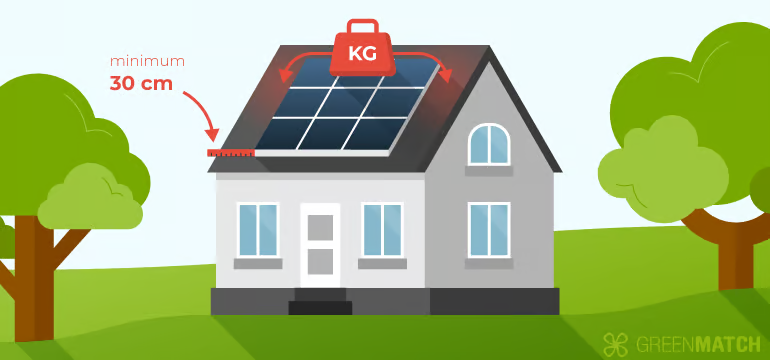
3. Size of the solar panel system
Solar cells come in all kinds of different shapes and sizes. The bigger the solar panel system, the more electricity is generated. After having calculated your electricity needs, you’ll get a better idea of what size panel you need for your home.
Monocrystalline panels are known to be the most efficient type of solar panel on the market, meaning you will require fewer panels (and therefore less roof space) to generate as much electricity as a polycrystalline system would.
4. Maintenance
It’s important to carry out the right solar panel maintenance in order to maximize the lifespan of your system. Fortunately, solar panels do not require much maintenance throughout their lifespan of 25-30 years.
Get your panels checked regularly by your installer or by another certified service provider. If you do this yourself, you may void your warranty in case you damage your panels in the process.
What you can do yourself is ensure your panels are clean at all times. This involves removing leaves and branches from your solar panel system, and rinsing them down with a garden hose – avoid sponging them down or touching them.
Pros and cons of solar panels in the US
There are many advantages of solar panels, and they play a significant role in the progress toward sustainability. Besides being environmentally friendly, solar cells provide significant savings on your electricity bill. While there are disadvantages to solar panels, the long-term benefits of investing in solar far outweigh the cons. There has been a slight increase in sunshine hours over the years, meaning you can get more and more out of your solar panel investment.
Solar panels can be a great way to cover your household electricity demands free of charge. However, there are downsides to solar panels that must also be considered. Below is a list of the main advantages and disadvantages of this renewable source of energy.
Advantages of solar panels
- Cheaper electricity bills
- Earn money back
- Year-round efficiency
- Low maintenance required
- Independent from the grid
- Reduce your carbon footprint
Cheaper electricity bills
With an increase in electric gadgets comes an increase in utility bills. You can reduce your electricity bills by incorporating solar panels into your household.
The energy produced by solar panels is completely free, and surplus energy can always be stored for future use, or exported back to the grid.
Earn money back
You can make money by selling surplus electricity back to the grid.
Year-round efficiency
Solar panels can work efficiently all year round. While they work optimally during the sunny months, they also produce a considerable amount of electricity during cloudy days and in the wintertime.
“Contrary to common belief, solar panels do not need heat to be effective. They simply need sunlight. That means solar panels can be effective even on cloudy days, and certainly during the winter months, too!”
Low maintenance required
Solar panels have an average lifespan of 25-30 years and require only little maintenance over these years. A good quality inverter might need to be changed every 10-15 years, but apart from that, you can enjoy the solar benefits under normal conditions.
It is a good idea to have your installer come and inspect your system regularly, in case of any cabling issues or loose brackets.
You should also clean your solar panels regularly, and ensure there are no leaves or branches on them. Roof-mounted solar panels are essentially self-cleaning, as rainfall can help clean the dust off the system.
Finally, ensure that there are no trees casting shadows over your panels, as this would reduce their efficiency.
Independent from the grid
Solar panels are ideal in remote areas where extending power lines to connect with electrical power grids would be too expensive. Solar PV systems are an affordable, effective solution for remote homes in rural areas of the country.
There is also the possibility of integrating solar batteries into your solar panel system. Solar batteries store the energy gathered by solar cells, saving it for rainy days or for use throughout the night.
Reduce your carbon footprint
Switching to solar energy significantly reduces your carbon footprint as it is a green, renewable source of energy. Unlike traditional electricity generators, like fossil fuels, coal, and oil, solar power does not release harmful carbon dioxide (CO2) or other pollutants.
Estimates also show that domestic solar panels could save around one tonne of CO2 per year, which means just one installation can offset approximately 25 tonnes of CO2 over its lifetime.
That is the amount of CO2 that around 50 fully grown trees would take 25 years to absorb. In other words, you can make a difference by going solar!
Disadvantages of Solar Panels
- High Initial Costs
- Significantly More Efficient During Daytime
- Solar Panel Placement
High Initial Costs
Investing in solar panels can be expensive. Although you can earn money back on your solar panels by exporting energy to the grid, the high set-up costs can be difficult to meet for some.
Significantly More Efficient During Daytime
Solar panels are dependent on sunlight. Although they do not require direct sunlight to work, they lose efficiency if they are not fully exposed to sunlight. In addition, they can’t produce energy during the night and are less effective during dark winters.
An effective solution to this is to switch to the main power grid at night. Alternatively, homes with a grid-independent system can store energy in solar batteries during the day, which can then be used at night.
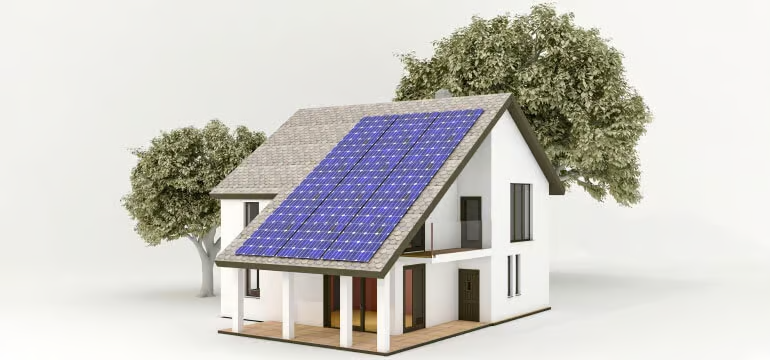
Solar Panel Placement
Inaccurate placement of solar panels can majorly reduce the effectiveness of electricity generation. If you live in an area surrounded by large buildings or tall trees, the efficiency of your solar panels will be very limited.
Ensure there are no buildings or trees blocking sunlight, and always clear branches and leaves from the panels.
What Types of Solar Cells Are There?
The most common types of domestic solar panels are monocrystalline panels, polycrystalline panels, and thin-film solar panels. There are additional types of solar panels on the market, however, these three are most commonly used for domestic purposes.
These three types of solar panels all produce electricity from sunlight, but it is important to be aware of their key differences.
Monocrystalline Solar Panels

Monocrystalline solar panels get their name because they are made of one piece of silicon. They are known as the most efficient type of solar panel on the market and can be identified by their sleek, black appearance.
When produced, the material that is used is single-crystal silicon, which is then cut into wafers. This allows for the electrons to flow freely, resulting in high-efficiency rates. This also makes them the most expensive domestic solar panel type.
Polycrystalline Solar Panels

Polycrystalline solar panels are produced by melting several pieces of silicon together into square moulds, forming solar cells. As there are multiple crystals in each solar cell, there is less space for electrons to move around, resulting in a lower efficiency rate compared to monocrystalline cells.
Polycrystalline panels are easier to produce than monocrystalline ones, and therefore also cheaper. They usually have a blue appearance, instead of the black hue of monocrystalline panels.
Thin-Film Solar Panels

Thin-film solar panels are easier to produce as they require less material. For that reason, they are the cheapest type of solar panel on the market. Thin-film solar panels are made by placing films of one or more PV materials onto a substrate and can be made into a flexible panel. There are various types of thin-film cells, including silicon, cadmium, and copper.
Thin-film panels are the least efficient on the market and require the most space. They are more tolerant to high temperatures, making them suitable for hotter countries.
What Are the Most Reputable Solar Panel Manufacturers?
Since the upswing of the use of renewable energy, there has been an increase in solar panel manufacturers on the global market. At GreenMatch, we work with both industry veterans that have been producing photovoltaic modules since the 1960s, and new players on the market that are making strides in solar energy technology.
Here is a breakdown of the top 12 solar panel manufacturers currently on the market:







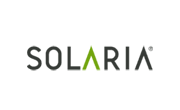




Has any of the solar panel models or manufacturers described so far sparked your interest? Click on the button below, and we will send you up to 3 offers tailored to your requirements from suppliers in your area. You are not obliged to accept any quote you receive.
Fill in the form in just 1 minute
7-Step Domestic Solar Panel Installation Guide
The solar panel installation process must be done correctly in order to get the most out of your solar panel system, otherwise, your panels will not reach their peak efficiency rate.
Before installing your solar panels, an MCS-certified installer will come and assess your roof. They will look at basic factors, such as roof orientation and angling, roof size, and how strong your roof is (to know how much weight it can hold).
To give you an idea of the solar panel installation process, follow our easy-to-understand 7-step guide:
Step 1: Erect the Scaffolding
To ensure safety for the installation team, scaffolding will be erected around your house.
Step 2: Attach Roof Anchors
After the scaffolding is set up, the installation team arrives. The team starts out by attaching the roof anchors, which will hold the base for the solar panels. The types of anchors used depend on the type of roof tile your home has.
Step 3: Attach the Frame
After the anchors have been installed, it’s time to attach the frame, which is made up of aluminium bars. The bars must be fitted in a straight direction and parallel to one another.
Step 4: Install the Solar Panels
Once the frame has been attached, the installation of the solar panels can begin. The panels are clamped to the aluminium frame — but not too tightly at first, in order to have some space to adjust them slightly later. Once all panels are set up in their position, they are firmly secured to the frame.
Step 5: Wire the Solar Panels
Now that the panels are fastened securely to the frame, the next step is to wire them. In most cases, the panels come wired from the manufacturer. However, these wires must be connected to the inverter, which would typically be in the attic.
The inverter is a component of the solar array that converts the absorbed energy from the panels into AC electricity, which can then be used by household appliances.
During the time of the wiring installation, the electricity supply to the household will need to be shut off.
Step 6: Make Final Connections to the Consumer Unit
After the panels are wired to the inverter, the final connections to the consumer unit will be made. A generation meter will also be connected, which measures how much electricity your panels actually produce. Smart meters and solar panels work together very well and can make meter reading far easier.
Step 7: Test the Solar Panels
After the panels, the inverter and the generation meter are all wired together, the installation needs to be tested. Once this is complete, the solar panel installation process has been successfully completed.
Do Solar Panels Affect House Insurance?
In most cases, when you install solar panels on your roof, your insurance should cover you under the current terms. However, since a solar panel installation results in a change to the home structure, it is always advised to contact your current insurance provider before proceeding with the installation.
It’s important to note that your home insurance may not include a cover for any damage by your solar panel or theft of the system. Therefore, it’s important to confirm with your insurance provider that your panels will also be covered.
Installing solar panels is a worthwhile investment for both homes and companies. They are a great step towards sustainability, reduce utility bills, and can even be a way for you to earn money back.

How Can You Find the Right Supplier?
Solar panels can be expensive, and you want to be sure you find the right solar supplier for your home. You should compare different solar panel providers and make sure you pick a reliable and certified installer.
Finding the right solar panel supplier on your own means investing a lot of time doing research. You could spend hours trying to find the best deal. We can make this process simpler for you, by providing you with up to 3 quotes from different suppliers in your area. This service is completely free and non-binding.
All you need to do is fill in a simple contact form, and we will then connect you with the most suitable installers near you. You can then compare these and get the best deal on solar panels!
Fill in the form in just 1 minute
Frequently Asked Questions
High initial costs and dependence on sunlight are often regarded as solar panels’ main disadvantages. However, the long-term benefits of investing in solar far outweigh the cons.
Based on the current trends, monocrystalline panels would be the best solar panels for homes. They are considered to be the most efficient solar panels available.
The high purity of monocrystalline panels makes them the most long lasting solar panels. Their efficiency rates are above 20% compared to other solar panels available in the market.
We strive to connect our customers with the right product and supplier. Would you like to be part of GreenMatch?

